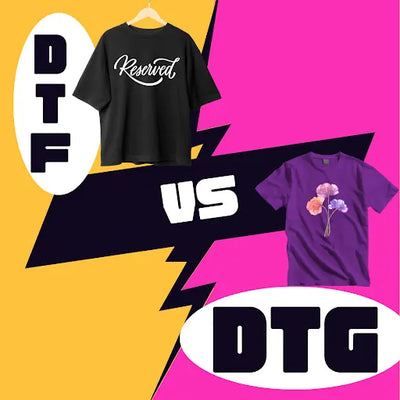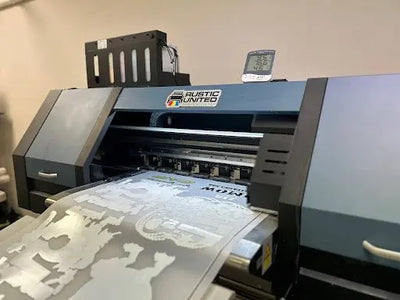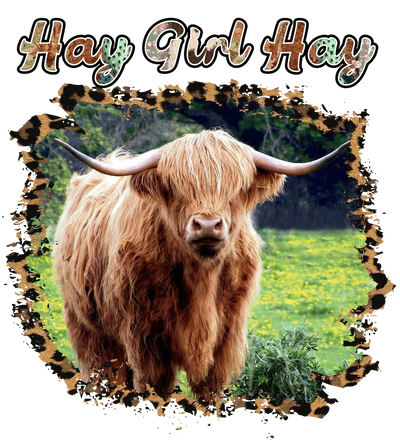

DTF vs DTG Printing: Key Differences Explained
Mar 4, 2024 (Updated on Sep 26, 2025)
In the world of garment printing, two popular methods have emerged as contenders: Direct-to-Garment (DTG) printing and Direct-to-Film (DTF) printing. Both methods have their strengths and serve different purposes in the realm of garment decoration.This article will explain all differences between DTF vs DTG Printing.
DTG printing involves using specialized inkjet printers to print full-color designs directly onto garments. It is known for its ability to reproduce intricate designs with fine details and a wide color gamut. On the other hand, DTF printing is a process where a design is printed onto a special transfer film and then transferred onto the garment using a heat press. DTF printing offers vibrant colors, strong opacity, and can be used on a wide range of fabrics.

Both DTG and DTF printing have their unique advantages. DTG printing excels in reproducing intricate designs with fine details and a wide range of colors. It is ideal for businesses prioritizing detailed designs and quick turnarounds. On the other hand, DTF printing offers versatility, vibrant colors, and durability, particularly on dark fabrics. It is suitable for those seeking vibrant colors, versatility, and durability on various fabrics.
Throughout this article, we will delve deeper into the differences between DTF and DTG printing, comparing their pros and cons, quality, durability, and cost. By the end, you will have a clearer understanding of which method may suit your specific needs and preferences.
Key Takeaways:
- DTG printing involves directly printing full-color designs onto garments using specialized inkjet printers.
- DTF printing involves printing the design onto a special transfer film and then transferring it onto the garment using a heat press.
- DTG printing is known for its ability to reproduce intricate designs with fine details and a wide color gamut.
- DTF printing offers vibrant colors, strong opacity, and versatility on various fabric types.
- The choice between DTG and DTF printing depends on specific needs and preferences.
The Process: DTG Printing vs DTF Printing
When it comes to garment printing, two popular methods have emerged: Direct-to-Garment (DTG) printing and Direct-to-Film (DTF) printing. Each method has its own unique process and benefits, catering to different printing needs.
DTG Printing Process
DTG printing involves using specialized inkjet printers to directly print full-color designs onto garments. The process is akin to using a desktop printer, but instead of paper, the printer applies ink to fabric. DTG printers use water-based or pigment inks that penetrate the fabric fibers, resulting in vibrant and durable prints. This printing method is highly effective at reproducing intricate designs with fine details and a wide color gamut.
DTG Printer: One well-known DTG printer brand is Brother GT-3 Series, which offers high-quality prints and advanced features.
DTF Printing Process
On the other hand, DTF printing involves a slightly different process. The design is first printed onto a special transfer film using a DTF printer. The DTF printer uses a heat transfer sublimation process to create a vibrant design on the film. Once the design is on the transfer film, it is then transferred onto the garment using a heat press. The heat press applies heat and pressure, causing the sublimation ink on the film to adhere to the fabric. DTF printing offers strong opacity, vibrant colors, and versatility in printing on various fabrics.
DTF Printer: One popular DTF printer brand is Epson SureColor F2100, known for its high-quality prints and efficient production.
"DTG printing directly applies ink to fabric, while DTF printing transfers designs from a special transfer film to the garment using a heat press."
Both DTG and DTF printing processes have their own advantages and can produce high-quality prints. The choice between the two methods depends on factors such as design complexity, fabric type, and desired print durability. By understanding the differences in the printing processes, you can make an informed decision when choosing the right method for your garment printing needs.
Printing Speed: DTG vs DTF
When it comes to speed, both DTG printing and DTF printing have their advantages and considerations. Let's compare them in terms of printing speed:
DTG Printing Speed
DTG printing is known for its efficiency and quick turnaround times. With specialized inkjet printers, the design is directly applied onto the garment, eliminating the need for layering or additional steps. DTG printers also have the capability to print multiple colors at once, further speeding up the process.
Advantages of DTG Printing Speed:
- Direct application: The printer prints the design directly onto the garment, reducing the overall printing time.
- Multiple color printing: DTG printers can print multiple colors simultaneously, minimizing the need for additional passes or setups.
- Efficient turnaround: Businesses prioritizing quick turnarounds can rely on DTG printing to meet deadlines and fulfill orders promptly.
DTF Printing Speed
DTF printing, on the other hand, involves a two-step process. The design is printed on a transfer film, and then the film is transferred onto the garment using a heat press. While this process may take longer compared to DTG printing, there are factors to consider:
Advantages of DTF Printing Speed:
- Transfer film preparation: Printing the design on the transfer film can be a relatively quick process.
- Heat press efficiency: Once the design is printed on the film, the transfer onto the garment using a heat press is a relatively fast step.
Although DTF printing may take slightly longer than DTG printing, many businesses find that the quality and durability of DTF prints make it worth the wait.
|
Printing Method |
Printing Speed |
|
DTG Printing |
Relatively quick |
|
DTF Printing |
Two-step process, longer printing time |
Durability and Washability: DTG vs DTF

When it comes to durability and washability, both DTG printing and DTF printing have their unique strengths and considerations.
DTG printing is known for its exceptional washability. The water-based or pigment inks used in DTG printing penetrate the fabric fibers, resulting in a soft and durable print. With proper care, DTG prints can withstand multiple washes without significant fading or cracking.
On the other hand, DTF printing offers durability through the use of a special transfer film. This film provides a thicker layer of ink, creating prints that can handle rough treatment. DTF prints have excellent stretchability and resistance to cracking, making them suitable for sportswear or garments that undergo frequent stretching and movement.
When considering washability, it's important to note that both DTG and DTF prints require proper care to maintain their longevity. Follow the garment's care instructions, such as washing in cold water, using mild detergents, and avoiding harsh chemicals or bleach.
Ultimately, the choice between DTG and DTF printing methods should consider the desired durability and washability of the final print, as well as the specific requirements of the garment or application.
Comparison of Durability and Washability: DTG vs DTF
|
DTG Printing |
DTF Printing |
|
|
Durability |
Soft and durable print that can withstand multiple washes without fading or cracking. |
Thicker layer of ink provides excellent durability and resistance to cracking. |
|
Washability |
Proper care can maintain the print's integrity after multiple washes. |
Resistant to stretching and movement, making it suitable for sportswear. |
Both DTG and DTF printing methods offer unique benefits in terms of durability and washability. Consider the specific requirements of your project and garments when making a decision.
Conclusion
After comparing DTG and DTF printing methods, it's clear that both have their own advantages and are suitable for different garment decoration needs. DTG printing shines in its ability to replicate intricate designs with fine details and a wide color range. This makes it an excellent choice for businesses that prioritize detailed designs and quick turnarounds.
On the other hand, DTF printing offers versatility, vibrant colors, and durability, especially on dark fabrics. If you're looking for prints that stand out with vibrant colors, can be applied to various fabrics, and withstand rough treatment, DTF printing is the way to go.
Ultimately, the decision between DTG and DTF printing comes down to your specific requirements and preferences. Consider factors such as the complexity of your designs, the desired color range, the type of fabrics you'll be printing on, and the durability needed for your garments. Whichever method you choose, both DTG and DTF printing are pushing the boundaries of garment decoration, fostering creativity, and driving innovation in the industry.
FAQ
What is the difference between DTF and DTG printing?
DTF printing involves printing a design onto a transfer film and then transferring it onto the garment using a heat press. DTG printing directly prints the design onto the garment using specialized inkjet printers.
Which printing method is better for reproducing intricate designs?
When it comes to durability and washability, both DTG printing and DTF printing have their unique strengths and considerations.
DTG printing is known for its exceptional washability. The water-based or pigment inks used in DTG printing penetrate the fabric fibers, resulting in a soft and durable print. With proper care, DTG prints can withstand multiple washes without significant fading or cracking.
On the other hand, DTF printing offers durability through the use of a special transfer film. This film provides a thicker layer of ink, creating prints that can handle rough treatment. DTF prints have excellent stretchability and resistance to cracking, making them suitable for sportswear or garments that undergo frequent stretching and movement.
When considering washability, it's important to note that both DTG and DTF prints require proper care to maintain their longevity. Follow the garment's care instructions, such as washing in cold water, using mild detergents, and avoiding harsh chemicals or bleach.
Ultimately, the choice between DTG and DTF printing methods should consider the desired durability and washability of the final print, as well as the specific requirements of the garment or application.
Comparison of Durability and Washability: DTG vs DTF
|
DTG Printing |
DTF Printing |
|
|
Durability |
Soft and durable print that can withstand multiple washes without fading or cracking. |
Thicker layer of ink provides excellent durability and resistance to cracking. |
|
Washability |
Proper care can maintain the print's integrity after multiple washes. |
Resistant to stretching and movement, making it suitable for sportswear. |
Both DTG and DTF printing methods offer unique benefits in terms of durability and washability. Consider the specific requirements of your project and garments when making a decision.
Conclusion
After comparing DTG and DTF printing methods, it's clear that both have their own advantages and are suitable for different garment decoration needs. DTG printing shines in its ability to replicate intricate designs with fine details and a wide color range. This makes it an excellent choice for businesses that prioritize detailed designs and quick turnarounds.
On the other hand, DTF printing offers versatility, vibrant colors, and durability, especially on dark fabrics. If you're looking for prints that stand out with vibrant colors, can be applied to various fabrics, and withstand rough treatment, DTF printing is the way to go.
Ultimately, the decision between DTG and DTF printing comes down to your specific requirements and preferences. Consider factors such as the complexity of your designs, the desired color range, the type of fabrics you'll be printing on, and the durability needed for your garments. Whichever method you choose, both DTG and DTF printing are pushing the boundaries of garment decoration, fostering creativity, and driving innovation in the industry.
FAQ
What is the difference between DTF and DTG printing?
DTF printing involves printing a design onto a transfer film and then transferring it onto the garment using a heat press. DTG printing directly prints the design onto the garment using specialized inkjet printers.
Which printing method is better for reproducing intricate designs?
DTG printing is known for its ability to reproduce intricate designs with fine details and a wide color gamut.
Which printing method offers vibrant colors and strong opacity?
DTF printing offers vibrant colors and strong opacity, making it suitable for printing on various fabrics, especially dark ones.
Is DTG printing faster than DTF printing?
Yes, DTG printing is relatively quick as the printer directly applies the design onto the garment. DTF printing involves a two-step process and may take longer.
Are DTG prints more durable than DTF prints?
DTG prints are known for their exceptional washability and durability, as the water-based or pigment inks used penetrate the fabric fibers. DTF prints offer durability as the transfer film provides a thicker layer of ink, making them resistant to cracking and suitable for sportswear or garments that undergo frequent stretching and movement.
Which printing method should I choose, DTG or DTF?
The choice between DTG and DTF printing depends on your specific needs and preferences. DTG printing is ideal for businesses prioritizing detailed designs and quick turnarounds, while DTF printing offers versatility, vibrant colors, and durability, particularly on dark fabrics.
Can both DTG and DTF printing methods be used for garment decoration?
Yes, both DTG and DTF printing methods have their unique strengths and serve different purposes in garment decoration.
Comments 0
Be the first to leave a comment.




